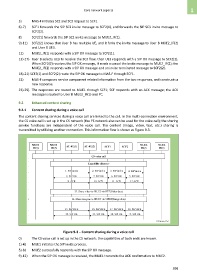Page 409 - 5G Basics - Core Network Aspects
P. 409
Core network aspects 1
5) MAS-F initiates SC2 and SC3 request to SCF1.
6)-7) SCF1 forwards the SIP SC2 invite message to SCF2(1), and forwards the SIP SC3 invite message to
SCF2(2).
8) SCF2(1) forwards the SIP SC2 invite message to MUE2_IF(1).
9)-11) SCF2(2) knows that User B has multiple UE, and it forks the invite message to User B MUE2_IF(2)
and User B UE3.
12) MUE2_IF(1) responds with a SIP OK message to SCF2(1).
13)-17) User B selects UE3 to receive the SC3 flow, then UE3 responds with a SIP OK message to SCF2(2).
When SCF2(2) receives the SIP OK message, it sends a cancel the invite message to MUE2_IF(2); the
MUE2_IF(2) responds with a SIP OK message and an invite terminated message to SCF2(2).
18)-21) SCF2(1) and SCF2(2) route the SIP OK message to MAS-F through SCF1.
22) MAS-F composes service component related information from the two responses, and constructs a
new response.
23)-29) The responses are routed to MUE1 through SCF1; SCF responds with an ACK message; the ACK
message is routed to User B MUE2_IF(1) and PC.
9.2 Enhanced content sharing
9.2.1 Content sharing during a voice call
The content sharing services during a voice call are linked to the call. In the multi-connection environment,
the CS voice call is set up in the CS network (the PS network also can be used for the voice call); the sharing
service functions are independent of the voice call. The content (image, video, text, etc.) sharing is
transmitted by utilizing another connection. This information flow is shown as Figure 9-3.
Figure 9-3 – Content sharing during a voice call
0) The CS voice call is set up in the CS network; the capabilities of both ends are known.
1)-4) MUE1 initiates the SIP invite process.
5)-8) MUE2 successfully responds with the SIP OK message.
9)-12) When the SIP OK message is received, the MUE1 transmits the ACK confirmation to MUE2.
399

